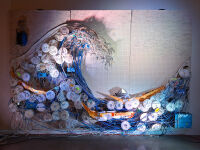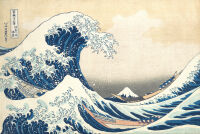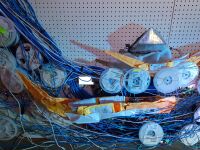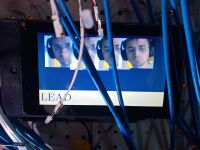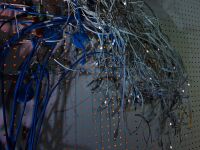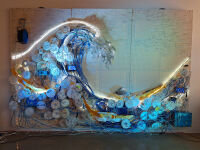What is it?
I was chosen as the second artist-in-residence at MoCA Arlington’s Innovation Studio (525 14th St S, Arlington, VA), and built a wall-sized artwork called “The Next Big Thing.” It borrows the form of Katsushika Hokusai’s “The Great Wave off Kanagawa,” recreated with colorful network cables, small screens, cameras, and surplus electronics. The artwork addresses the cycle of hype surrounding new products and incorporates the artist’s own Google, Facebook, and Twitter data profiles, as well as responding to the faces and presence of viewers.
The artwork was at the MoCA Arlington Innovation Studio & Store (525 14th St S) through April 25.
“The Next Big Thing” is a wooden structure with front pegboards, on to which I outlined the main features of “The Great Wave off Kanagawa” with soft graphite. The main form of the wave is Ethernet cables suspended with pegboard hooks; these cables are also functional, forming a local network with a switch and router also attached to the board.
This network is used to interconnect ten computers which cooperatively respond to viewer presence using artist-made software. Distance, infrared, and Doppler radar sensors detect proximity and motion; cameras seek faces. These datapoints are shown with a multitude of small screens nestled within the waves. (Viewer data is only retained for two minutes.)
Details from the original print are recreated with items that invoke the manufacture, distribution, and interconnection of consumer electronics. The churning white “claws” of the original print are transformed into white spools of miniature electronic components used in the creation of circuit boards (spools of SMD passives such as 0201 resistors), some of which are partially unspooled to add further wave detail. The boats are crafted with reused bubble mailers, invoking the lengthy journey of drop-shipped products. They contain no people; conceptually, viewers stand in for the fishers depicted in Hokusai’s “Great Wave.”
When viewers have been absent for some time, the wave is static and the screens show a detail of wave spray from Hokusai’s original print.
After viewers are initially detected, full-color, computer-controlled theater wash lights begin to shimmer, animating the wave through gently changing colors; dangling LEDs on individual wires sparkle. When approached, charts begin to show viewer distance from the artwork or recently observed motion; faces are recognized and individually collated with labels such as “User,” “Consumer,” or “Qualified Lead.”
Should enough faces be observed by the artwork, it enters a stormy mode: the sea and sky roil green and grey, and concealed LED strips along the wave edge flash with “lightning.” The artwork’s “Mt. Fuji” (a repurposed automotive lighting module) shows a lighthouse-like pattern, and the dangling LEDs show a churning sea.
In the clouds above the wave are découpaged strips of the artist’s personal data profiles from Google, Facebook, and Twitter: items purchased, locations visited, and ads viewed. Should a viewer closely approach the artwork to read these slices of data, hidden lights behind the pegboard gently begin to glow in a surprising moment.
